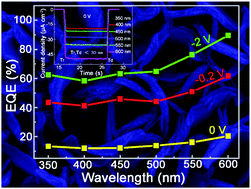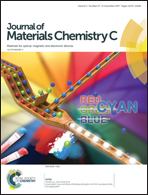A self-powered broadband photodetector based on an n-Si(111)/p-NiO heterojunction with high photosensitivity and enhanced external quantum efficiency†
Abstract
A self-powered high-performance broadband photodetector was fabricated, based on n-Si(111)/p-NiO heterojunctions consisting of single-crystal NiO nanosheets, via a facile hydrothermal method. The device exhibited broadband detection capabilities (350–600 nm) and excellent self-powered performance, with an external quantum efficiency (EQE) as high as ∼20% under zero bias. Under a low reverse bias of −0.2 V, the highest photosensitivity (photo-dark current ratio) values of 938% and 2249% were achieved under illumination from 350 nm and 600 nm light (0.5 mW cm−2), respectively, which was several orders of magnitude higher than for previously reported Si/NiO heterojunction photodetectors. Under a high reverse bias of −2 V, the excellent EQE of the device was found to be between 62.5% and 89.5% upon illumination from 350–600 nm light. In addition, the fast response speed of the as-fabricated device was less than 30 ms. The results indicate that n-Si(111)/p-NiO heterojunction photodetectors made of single-crystal NiO nanosheets have obvious advantages for application in high-performance and energy-saving optoelectronic devices.



 Please wait while we load your content...
Please wait while we load your content...